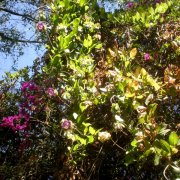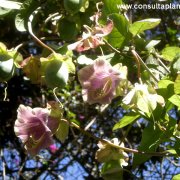Care of the climbing plant Cobaea scandens or Mexican ivy |
|
The genus Cobaea, family Polemoniaceae, comprises 20 species of climbing plants native to tropical regions of America, especially Mexico. Some species are: Cobaea scandens, Cobaea pringlei, Cobaea lutea, Cobaea minor, Cobaea penstemon. Common names: Mexican ivy, Monastery bells, Cup-and-saucer vine, Cathedral bells. This species is native to Mexico. They are semi-shrubby climbing plants that reach 6 meters (19.68 feet) in height. In non-tropical regions they behave like annual plants. The leaves are alternate and are formed by 2-3 elliptical leaflets; they end in a tendril that is used by the plant to climb. The attractive flowers (5 cm/1.96" in diameter) are greenish-yellow in color and then purple; they have a curious cup shape with a chalice that looks like a plate; they last a few days but produce many flowers. They bloom throughout the summer until early winter. These very fast growing vines are used to cover pergolas and walls; Mexican ivy is also used on balconies and terraces in pots of at least 30 cm (11.8") wide by 70 cm (27.5") deep. Cobaea scandens prefers a semi-shade exposure (especially in a Mediterranean climate); it can be grown in full sun if the fall is cool. It's a tropical plant that does not resist cold or frost. The soil can be a mixture of 1/2 normal garden substrate with 1/4 peat and 1/4 coarse sand. The planting of the seedlings obtained from seeds is done during the first half of spring. Water (with lime-free water) every 2 days in summer and reduce watering in autumn. Sprinkle the leaves occasionally with lime-free water if it's very hot. Fertilize with organic powdered fertilizer at the time of planting and with mineral fertilizer once a month during the flowering season. In tropical and subtropical regions it's advisable to prune them after flowering to a third of the length of the branches. Protect the base of the plant with dry leaves in late fall. Monastery bells can be attacked by mites and aphids if the humidity is low. Cathedral bells propagates by seeds sown in late winter or by cuttings in early summer. |
Images of the climbing plant Cobaea scandens or Mexican ivy |
Find plants
Cobaea scandens or Mexican ivy | Care and Growing
© 2025 FavThemes



